Google 5 billionth search Scam. 2021 update.
5 Billionth Search scam Removal Guide
What is 5 Billionth Search scam?
Google 5 Billionth Search website is a scam aiming to expose users to other advertising content
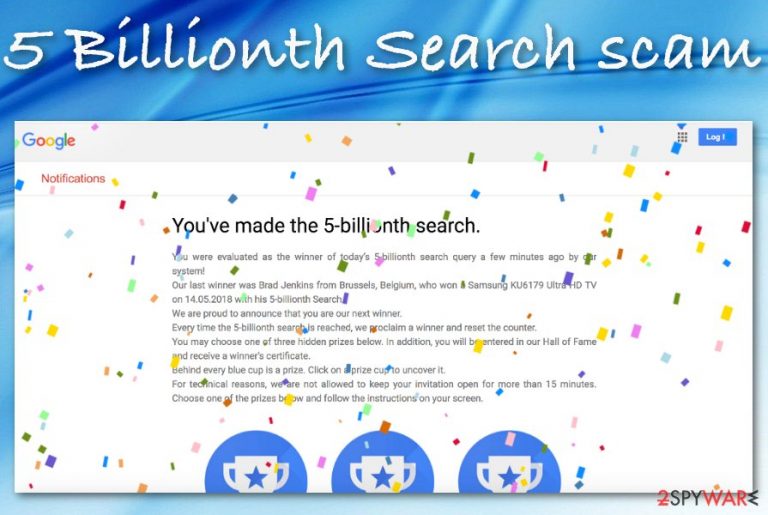
Google 5 Billionth Search is a misleading notification claiming that you've made the 5-billionth search query recently and will be rewarded with some type of prize. It looks very attractive by providing false information about recent winners one of which appears to be someone named Brad Jenkins from Brussels, Belgium who won a Samsung KU6179 Ultra HD TV. Afterward, the virus states that you are the next winner and in order to claim the prize, you have to pick one that is hidden behind three blue cups at the bottom of the message. Hackers who are standing behind this questionable notification also warn users that this message will lurk no longer than 15 minutes, and this is like a little push towards picking a prize faster.
| Name | Google 5 Billionth Search scam |
|---|---|
| Type | Scam app |
| Goal | The main purpose of this scam is to encourage users to click on the fake prizes provided. Once the user clicks there, anything can happen – the person can be asked to fill in personal information, credentials, or redirected to a sponsored domain |
| Cause | The misleading message can start appearing as a result of adware or another PUP infection lurking on your computer system. Also, it is provided by third-party websites such as topreward.site |
| Removal | You can get rid of the suspicious content by using a reliable antimalware product or by completing manual guiding steps like those ones that are provided at the end of this article |
| Fix tip | If you have encountered any compromised areas on your computer, you can try recovering them with the help of FortectIntego |
The main reason why you are seeing prize scams frequently might be a potentially unwanted program that has infiltrated your computer system unknowingly. These apps are capable of installing on targeted devices by manipulating weak downloading settings and using freeware installations from third-party downloading websites such as soft32.com, softonic.com, cnet.com, and download.com.
Even if You've made the 5 Billionth search pop-up scam appears just once or twice while browsing the Internet sphere, you should still avoid believing in it. The scam message will try to encourage you to select a specific cup by promising that under each one there is a prize waiting for you. Also, the creators of this notification claim that you will be included in their Hall of Fame and receive some type of winner certificate. Take a look at the entire message:
You've made the 5-billionth search.
You were evaluated as the winner of today's 5-billionth search query a few minutes ago by our system!
Our last winner was Brad Jenkins from Brussels, Belgium, who won a Samsung KU6179 Ultra HD TV on 14.05.2018 with his 5-billionth Search.
We are proud to announce that you are our next winner.
Every time the 5-billionth search is reached, we proclaim a winner and reset the counter.
You may choose one of three hidden prizes below. In addition, you will be entered in our Hall of Fame and receive a winner's certificate.
Behind every blue cup is a prize. Click on a prize cup to uncover it.
For technical reasons, we are not allowed to keep your invitation open for more than 15 minutes. Choose one of the prizes below and follow the instructions on your screen.
According to peoples' reviews on Reddit.com,[1] 5 Billionth Search scam can appear from a website called topreward.site that is marked as a deceptive site ahead while trying to enter it via the Google Chrome web browser. If you receive any type of notification from this domain, you should click the “x” closing button on the upper right corner of your browser window.
Do not click anywhere where this scam wants you to click on. By trying to claim a specific prize, you are likely to be loaded with congratulations notifications that you have won some type of electronic device, gift card, etc. However, then you might be asked to provide some personal or credential information. This is where the trickiest part starts.
Do not enter any personally-identifiable or sensitive data that can easily get misused in ID theft or monetary swindles. Hackers who are behind this message might try to gather such information for illegitimate purposes. You might also be asked to transfer a starter price that is claimed to be necessary for receiving the prize. However, note that there is no reward waiting for you and you will just fill up the scammers' pockets with monetary income.
Furthermore, if you click on Google 5 Billionth Search scam, you might get redirected to some unknown places. These locations might be sponsored by various developers but they might also carry infectious payload and get you infected with dangerous malware such as a Trojan horse or ransomware virus that can result in file loss, system and software destruction, personal information theft, and similar.
In case the scam is a result of some type of adware program that is lurking on your computer, you can start expecting other unwanted activities that will likely appear soon on your device if they did not have approached you yet. Adware apps are responsible for the delivery of advertising content and sponsored offers. These PUPs aim to collect pay-per-click[2] income from each click that is made on their ads.

If adware is responsible for the appearance of 5 Billionth Search scam, you might also spot some changes in your web browsers such as Google Chrome, Mozilla Firefox, Internet Explorer, Microsoft Edge, and Safari. The suspicious app can make an impact on major settings such as the homepage, new tab URL, and fill the browsers with questionable extensions, plug-ins, and add-ons.
Continuously, adware programs are capable of recording browsing-related information such as Internet Protocol address,[3] geographic location, recently visited websites, hyperlinks clicked, your browser type, etc. When this type of data is recorded, developers can share it with other parties for receiving income or use the collected information for developing targeted advertising campaigns.
To complete the full scam removal, you need to eliminate the cause of this scam message. For this purpose, scan the entire computer system with a reliable antimalware product that will detect all the infected sources and potentially unwanted content that might be brought to the machine during the adware infiltration period.
You can remove scam and the PUP behind it by using automatic software that is capable of dealing with the cyber threat within a few minutes of time. Also, you can try employing FortectIntego for fixing any damage that might have been performed to your computer system. If you are curious to try to get rid of the scam and the PUP by yourself, at the end of this article, we have also provided some manual step-by-step guidelines.
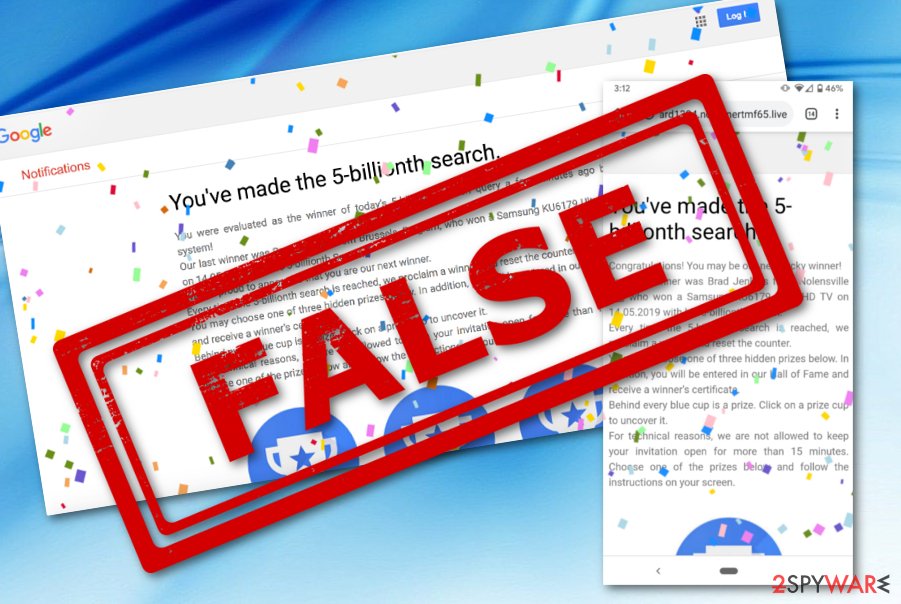
Learning about PUP delivery and preventing it
Cybersecurity experts from LosVirus.es[4] claim that potentially unwanted programs are always using deceptive techniques to arrive at their destinations. Most commonly, the “software bundling” technique is employed by various third-parties and seems to be very effective regarding the big number of users who often get infected with adware and other PUPs.
The suspicious product often gets installed to the computer system through other freeware or shareware that users download from unsecured sources such as download.com, softonic.com, and cnet.com. Be aware that you should always pick the Custom or Advanced installation mode in order not to let any suspicious downloads take place on your computer. Here, opt-out of all of the products that you do not want to see on your device.
Furthermore, adware apps and similar threats can get distributed through infectious advertisements and hyperlinks that were are able to meet on deceptive domains. If your web browser or security software is warning you that there is a potentially suspicious or malicious website ahead, you should avoid visiting it. Also, be careful with fake software updates as some of them might also be designed for the installation of PUPs.
Getting rid of PUP and scam from your computer is a must
Full removal involves getting rid of its cause that is likely to be some type of adware program. For this purpose, you can employ automatic security products like AV programs that will help to get rid of the potentially unwanted program within minutes of time. Also, this type of software will ensure that there are no suspicious components left lurking in your computer system after the elimination process is completed. Note that, if you leave any content related to this virus on your PC, the scam might return with its messages repeatedly.
There also is another technique that you can use to remove 5 Billionth Search scams and their cause from your device. This method required cleaning the entire OS manually and also refreshing possibly-affected web browser applications such as Google Chrome, Mozilla Firefox, Internet Explorer, Microsoft Edge, and Firefox. You might use the help of automatic tools like PC repair app to ensure there are not damaged files left on your PC.
You may remove virus damage with a help of FortectIntego. SpyHunter 5Combo Cleaner and Malwarebytes are recommended to detect potentially unwanted programs and viruses with all their files and registry entries that are related to them.
Getting rid of 5 Billionth Search scam. Follow these steps
Uninstall from Android
Uninstall unwanted programs from Android device:
- Go to Settings -> Apps/Applications.
- Expand the full list of the installed apps.
- Scroll through the list and tap on a suspicious application once.
- Tap on it and select Uninstall.
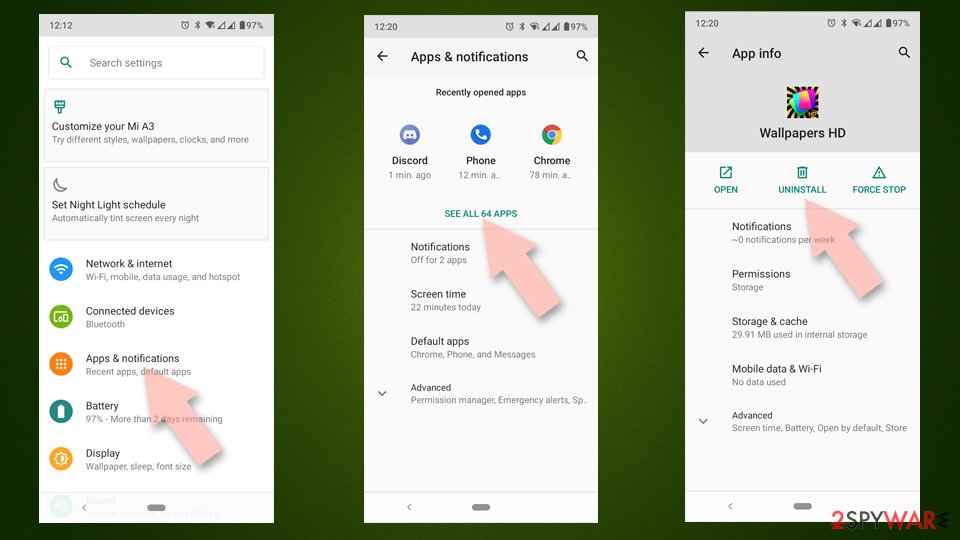
- Reboot the device.
Clear Storage and data files on Android from Google Chrome or other apps:
- Go to Settings > Apps/Applications.
- Expand the full list of the installed apps.
- Tap on Chrome and select Storage & cache.
- Clear storage and clear cache of the app.
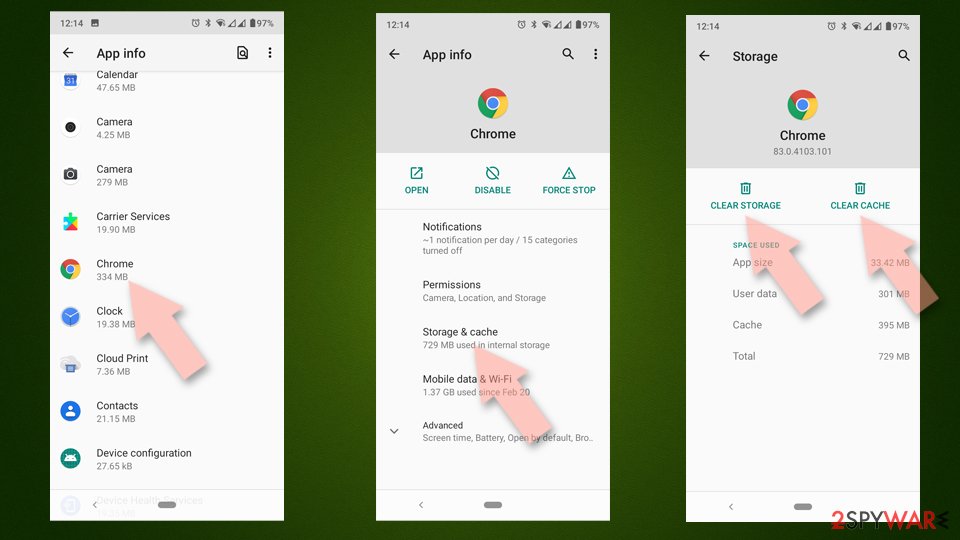
If you are seeing ads on top of other apps but are not sure what is causing it, perform the following steps:
- Go to Apps/Applications.
- Tap Advanced.
- Select Special App access.
- Tap on Display over other apps.
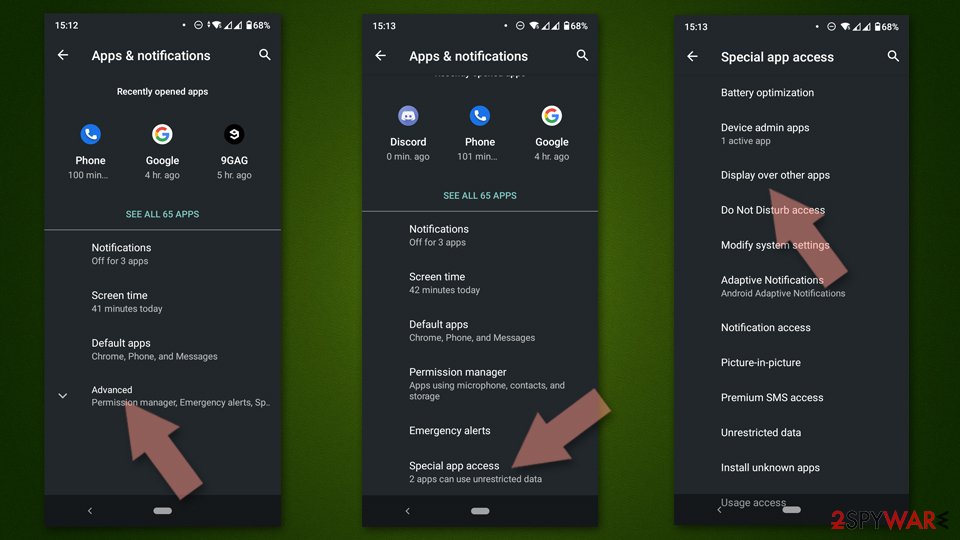
- Eliminate apps with these access rights enabled.
Stop browser notifications
Remove unwanted notifications from Google Chrome (desktop):
- Open Google Chrome browser and go to Menu > Settings.
- Scroll down and click on Advanced.
- Locate Privacy and security section and pick Site Settings > Notifications.

- Look at the Allow section and look for a suspicious URL.
- Click the three vertical dots next to it and pick Block. This should remove unwanted notifications from Google Chrome.

Remove unwanted notifications from Google Chrome (Android):
- Open Google Chrome and tap on Settings (three vertical dots).
- Select Notifications.
- Scroll down to the Sites section.
- Locate the unwanted URL and toggle the button to the left (Off setting).

Remove unwanted notifications from Mozilla Firefox:
- Open Mozilla Firefox and go to Menu > Options.
- Click on Privacy & Security section.
- Under Permissions, you should be able to see Notifications. Click the Settings button next to it.

- In the Settings – Notification Permissions window, click on the drop-down menu by the URL in question.
- Select Block and then click on Save Changes. This should remove unwanted notifications from Mozilla Firefox.

Remove unwanted notifications from Safari:
- Click on Safari > Preferences…
- Go to the Websites tab and, under General, select Notifications.
- Select the web address in question, click the drop-down menu and select Deny.

Remove unwanted notifications from MS Edge:
- Open Microsoft Edge, and click the Settings and more button (three horizontal dots) at the top-right of the window.
- Select Settings and then go to Advanced.
- Under Website permissions, pick Manage permissions and select the URL in question.

- Toggle the switch to the left to turn notifications off on Microsoft Edge.

Remove unwanted notifications from MS Edge (Chromium):
- Open Microsoft Edge, and go to Settings.
- Select Site permissions.
- Go to Notifications on the right.
- Under Allow, you will find the unwanted entry.
- Click on More actions and select Block.

Remove unwanted notifications from Internet Explorer:
- Open Internet Explorer, and click on the Gear icon at the top-right of the window.
- Select Internet options and go to the Privacy tab.
- In the Pop-up Blocker section, click on Settings.
- Locate web address in question under Allowed sites and pick Remove.

Uninstall from Windows
Instructions for Windows 10/8 machines:
- Enter Control Panel into Windows search box and hit Enter or click on the search result.
- Under Programs, select Uninstall a program.

- From the list, find the entry of the suspicious program.
- Right-click on the application and select Uninstall.
- If User Account Control shows up, click Yes.
- Wait till uninstallation process is complete and click OK.

If you are Windows 7/XP user, proceed with the following instructions:
- Click on Windows Start > Control Panel located on the right pane (if you are Windows XP user, click on Add/Remove Programs).
- In Control Panel, select Programs > Uninstall a program.

- Pick the unwanted application by clicking on it once.
- At the top, click Uninstall/Change.
- In the confirmation prompt, pick Yes.
- Click OK once the removal process is finished.
Delete from macOS
Remove items from Applications folder:
- From the menu bar, select Go > Applications.
- In the Applications folder, look for all related entries.
- Click on the app and drag it to Trash (or right-click and pick Move to Trash)

To fully remove an unwanted app, you need to access Application Support, LaunchAgents, and LaunchDaemons folders and delete relevant files:
- Select Go > Go to Folder.
- Enter /Library/Application Support and click Go or press Enter.
- In the Application Support folder, look for any dubious entries and then delete them.
- Now enter /Library/LaunchAgents and /Library/LaunchDaemons folders the same way and terminate all the related .plist files.

Remove from Microsoft Edge
Delete unwanted extensions from MS Edge:
- Select Menu (three horizontal dots at the top-right of the browser window) and pick Extensions.
- From the list, pick the extension and click on the Gear icon.
- Click on Uninstall at the bottom.

Clear cookies and other browser data:
- Click on the Menu (three horizontal dots at the top-right of the browser window) and select Privacy & security.
- Under Clear browsing data, pick Choose what to clear.
- Select everything (apart from passwords, although you might want to include Media licenses as well, if applicable) and click on Clear.

Restore new tab and homepage settings:
- Click the menu icon and choose Settings.
- Then find On startup section.
- Click Disable if you found any suspicious domain.
Reset MS Edge if the above steps did not work:
- Press on Ctrl + Shift + Esc to open Task Manager.
- Click on More details arrow at the bottom of the window.
- Select Details tab.
- Now scroll down and locate every entry with Microsoft Edge name in it. Right-click on each of them and select End Task to stop MS Edge from running.

If this solution failed to help you, you need to use an advanced Edge reset method. Note that you need to backup your data before proceeding.
- Find the following folder on your computer: C:\\Users\\%username%\\AppData\\Local\\Packages\\Microsoft.MicrosoftEdge_8wekyb3d8bbwe.
- Press Ctrl + A on your keyboard to select all folders.
- Right-click on them and pick Delete

- Now right-click on the Start button and pick Windows PowerShell (Admin).
- When the new window opens, copy and paste the following command, and then press Enter:
Get-AppXPackage -AllUsers -Name Microsoft.MicrosoftEdge | Foreach {Add-AppxPackage -DisableDevelopmentMode -Register “$($_.InstallLocation)\\AppXManifest.xml” -Verbose

Instructions for Chromium-based Edge
Delete extensions from MS Edge (Chromium):
- Open Edge and click select Settings > Extensions.
- Delete unwanted extensions by clicking Remove.

Clear cache and site data:
- Click on Menu and go to Settings.
- Select Privacy, search and services.
- Under Clear browsing data, pick Choose what to clear.
- Under Time range, pick All time.
- Select Clear now.

Reset Chromium-based MS Edge:
- Click on Menu and select Settings.
- On the left side, pick Reset settings.
- Select Restore settings to their default values.
- Confirm with Reset.

Remove from Mozilla Firefox (FF)
Remove dangerous extensions:
- Open Mozilla Firefox browser and click on the Menu (three horizontal lines at the top-right of the window).
- Select Add-ons.
- In here, select unwanted plugin and click Remove.

Reset the homepage:
- Click three horizontal lines at the top right corner to open the menu.
- Choose Options.
- Under Home options, enter your preferred site that will open every time you newly open the Mozilla Firefox.
Clear cookies and site data:
- Click Menu and pick Settings.
- Go to Privacy & Security section.
- Scroll down to locate Cookies and Site Data.
- Click on Clear Data…
- Select Cookies and Site Data, as well as Cached Web Content and press Clear.

Reset Mozilla Firefox
If clearing the browser as explained above did not help, reset Mozilla Firefox:
- Open Mozilla Firefox browser and click the Menu.
- Go to Help and then choose Troubleshooting Information.

- Under Give Firefox a tune up section, click on Refresh Firefox…
- Once the pop-up shows up, confirm the action by pressing on Refresh Firefox.

Remove from Google Chrome
Delete malicious extensions from Google Chrome:
- Open Google Chrome, click on the Menu (three vertical dots at the top-right corner) and select More tools > Extensions.
- In the newly opened window, you will see all the installed extensions. Uninstall all the suspicious plugins that might be related to the unwanted program by clicking Remove.

Clear cache and web data from Chrome:
- Click on Menu and pick Settings.
- Under Privacy and security, select Clear browsing data.
- Select Browsing history, Cookies and other site data, as well as Cached images and files.
- Click Clear data.

Change your homepage:
- Click menu and choose Settings.
- Look for a suspicious site in the On startup section.
- Click on Open a specific or set of pages and click on three dots to find the Remove option.
Reset Google Chrome:
If the previous methods did not help you, reset Google Chrome to eliminate all the unwanted components:
- Click on Menu and select Settings.
- In the Settings, scroll down and click Advanced.
- Scroll down and locate Reset and clean up section.
- Now click Restore settings to their original defaults.
- Confirm with Reset settings.

Delete from Safari
Remove unwanted extensions from Safari:
- Click Safari > Preferences…
- In the new window, pick Extensions.
- Select the unwanted extension and select Uninstall.

Clear cookies and other website data from Safari:
- Click Safari > Clear History…
- From the drop-down menu under Clear, pick all history.
- Confirm with Clear History.

Reset Safari if the above-mentioned steps did not help you:
- Click Safari > Preferences…
- Go to Advanced tab.
- Tick the Show Develop menu in menu bar.
- From the menu bar, click Develop, and then select Empty Caches.

After uninstalling this potentially unwanted program (PUP) and fixing each of your web browsers, we recommend you to scan your PC system with a reputable anti-spyware. This will help you to get rid of 5 Billionth Search scam registry traces and will also identify related parasites or possible malware infections on your computer. For that you can use our top-rated malware remover: FortectIntego, SpyHunter 5Combo Cleaner or Malwarebytes.
How to prevent from getting adware
Choose a proper web browser and improve your safety with a VPN tool
Online spying has got momentum in recent years and people are getting more and more interested in how to protect their privacy online. One of the basic means to add a layer of security – choose the most private and secure web browser. Although web browsers can't grant full privacy protection and security, some of them are much better at sandboxing, HTTPS upgrading, active content blocking, tracking blocking, phishing protection, and similar privacy-oriented features. However, if you want true anonymity, we suggest you employ a powerful Private Internet Access VPN – it can encrypt all the traffic that comes and goes out of your computer, preventing tracking completely.
Lost your files? Use data recovery software
While some files located on any computer are replaceable or useless, others can be extremely valuable. Family photos, work documents, school projects – these are types of files that we don't want to lose. Unfortunately, there are many ways how unexpected data loss can occur: power cuts, Blue Screen of Death errors, hardware failures, crypto-malware attack, or even accidental deletion.
To ensure that all the files remain intact, you should prepare regular data backups. You can choose cloud-based or physical copies you could restore from later in case of a disaster. If your backups were lost as well or you never bothered to prepare any, Data Recovery Pro can be your only hope to retrieve your invaluable files.
- ^ Google phishing: You've made the 5-billionth search. Reddit. Forums and comments.
- ^ Pay-per-click. Wikipedia. The free encyclopedia.
- ^ Stephanie Crowford. What is an IP address?. Computer. How Stuff Works.
- ^ LosVirus. LosVirus.es. Security and spyware news.
